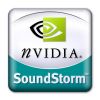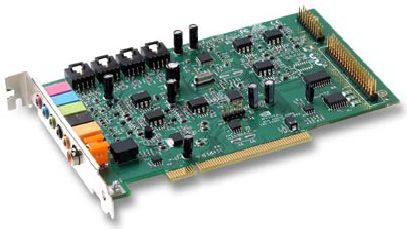Audio Processing Unit (APU)

The MCP-T is Dolby capable however there is a licence fee to expose the functionality hence not all motherboard makers do in all configurations, which restricts the audio capabilities of the nForce chipset. With nForce2 NVIDIA are trying to clarify which motherboard configurations will fully expose all the APU capabilities by utilising the brand ‘SoundStorm’. The following table highlights the audio capabilities of the APU and what differentiates the normal APU specifications from those that can be designated ‘SoundStorm’
|
Feature |
NVIDIA nForce APU |
NVIDIA SoundStorm |
|
DSP or HW-accelerated 2D (Stereo) Voices |
256 voices |
256 voices |
|
DSP or HW-accelerated 3D Voices |
64 3D voices |
64 3D voices |
|
DX8 HW-Submixer |
32 HW submixers |
32 HW submixers |
|
DLS2 Acceleration |
Yes |
Yes |
|
Per Voice Parametric EQ |
Yes |
Yes |
|
Occlusion and Obstruction |
Yes |
Yes |
|
Near Field Effects |
Yes |
Yes |
|
EAX2 and I3DL2 Reverb |
Yes |
Yes |
|
Global Effects (Reverb, Chorus etc) |
Yes |
Yes |
|
Speakers |
2 speakers |
2, 4, or 6 speakers |
|
Microphone/Line Inputs |
>Yes |
Yes |
|
SPDIF Interface |
No |
Yes |
|
Software and Utilities |
Basic |
Enhanced |
|
H/W Dolby Digital Encode |
No |
Yes |

SoundStorm Connection Riser Board
Interestingly NVIDIA dropped the hint that nForce2 would be the first product that the SoundStorm brand will be utilised on, however they have demonstrated others behind closed doors. What these other products are will remain a mystery at the moment however it is unlikely to be add-in sound boards as NVIDIA believe that this should be integrated.
The use of the SPDIF interconnect in conjunction with a Dolby Digital Processor allows for the APU to produce a Dolby Digital Encoded sound stream.
Dolby Digital Setup
The nForce APU is a DirectX8 audio processor and allows for the following features to be processed in hardware, rather then the Host CPU:
- Downloadable Sounds Version 2 (DLS2): The APU can perform layering and filtering using stereo waves as the source.
- Effects processing on DirectSound buffers: More sophisticated sound effects as well as higher quality music and sound effects with greater production values and real-time interactive control.
- Interactive 3D Audio Level 2 (I3DL2): Reverberation and occlusion/obstruction support.
- Sub-mixed audio streams: Complex, rich sounds can be created by sub-mixing two or more audio streams.
In addition to the DX8 features listed above the APU can also perform the following processes in hardware:
- Head Reference Transfer Functions (HRTF) algorithms with cross talk cancellation
- Near field effects
- Macro effects
- 7-band graphic equalizer

